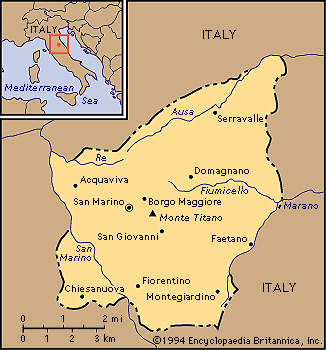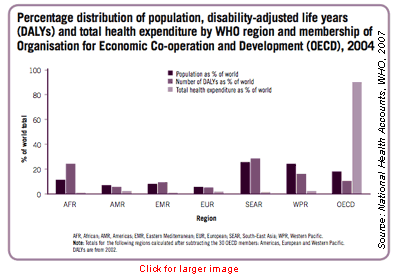Center for Communications, Health and the Environment

Health Budgets Affect Global Disease Burden, Life Expectancy
In 2004, the world spent a total of Intl $4.9 trillion on health. But the geographical distribution of these financial resources was uneven, and it continues to remain so, according to the World Health Organization's National Health Accounts (http://www.who.int/nha). *
In fact, a mere 30 countries spend 90 percent of the world's health resources. Even more telling is that these countries – all members of the Organisation for Economic Co-operation and Development (OECD) – comprise less than 20 percent of the world's population.
Including countries such as Australia, Japan , most Western European nations, Canada and the United States, OECD countries spend an average of 11 percent of their gross domestic product (GDP) on health. This is a significantly larger share than other nations, including those in WHO's African and South-East Asia regions, where health expenditures average only 4.7 percent of GDP. Such percentages translate into per capita spending on health of about Intl $3,080 in OECD countries compared with Intl $102 in countries in the African and South-East Asia regions, which are much poorer. **
Linking this spending to epidemiology, WHO data show that:
- Poorer regions, such as Africa and South-East Asia, comprise 37 percent of the world's population and account for the largest share of the global disease burden, with more than 50 percent of global disability-adjusted life years lost, but spend only about 2 percent of the world's health resources.
- The Western Pacific Region, excluding Australia, Japan, New Zealand and the Republic of Korea, accounts for 24 percent of the world's population (dominated by China) and about 18 percent of the global burden of disease, but only another 2 percent of the world's health resources.
- The Region of the Americas and the European Region, excluding the OECD countries, account for about 12 percent of the world's population and 11 percent of the global burden of disease, and spend slightly less than 5 percent of all global health resources.
In short, richer countries with smaller populations and lower disease burdens use more health resources than poorer countries with larger populations and higher disease burdens. Not only does this fact highlight the need for additional resources for poorer countries and raise questions about the efficiency of spending on health in richer countries, but it also clarifies the correlation between health expenditure and disease burden. Such a situation also explains the global differences in life expectancy, according to WHO's World Health Statistics 2007 (http://www.who.int/whosis/en/), which compares the latest (2005) life expectancy figures for 193 member countries and notes that many of the nations that fared badly spent much less money on health.
In essence, and not surprisingly, people in richer countries with smaller populations and lower disease burdens due to higher health expenditures live longer than individuals in poorer countries with larger populations and higher disease burdens due to lower health expenditures.
According to the May 2007 report, San Marino, a tiny republic surrounded by Italy that spent Intl $3,198 per person or 7.4 percent of its GDP on health in 2004, offers the world's longest male life expectancy at 80 years. Meanwhile, females in Japan, an OECD country that traditionally leads the world tables and spent 7.8 percent of its GDP, or Intl $2,293 per capita, in 2004, have a life expectancy of 86 years.

Following San Marino on the male side were Australia, Iceland, Japan, Sweden and Switzerland at 79 years and then Canada, Israel, Italy, Monaco and Singapore at 78. At 77 years, France was in a group of countries including New Zealand and Britain. Germany was at 76 years. Cuba was among the countries that tied the United States at 75 years.
Countries with long-living women include Monaco at 85 years, and Andorra, Australia, France, Italy, San Marino, Spain and Switzerland at 84. Canada tied Iceland and Sweden at 83 years, and Germany was in a group at 82 years. Britain came in at 81 years, with Costa Rica, Denmark and the United States at 80 years.
Sierra Leone registered the shortest male life expectancy at 37 years – the same as that of girls in Swaziland, who were at the bottom of the female list. These countries spent Intl $34 per person or 3.3 percent of GDP, and Intl $367 per capita or 6.3 percent of GDP on health in 2004 respectively, with Swaziland women also battling social and economic exclusion. Meanwhile, Afghanistan is the toughest place for babies, with an infant mortality rate of 165 in 1,000 live births, compared with the two babies who die per 1,000 born in Singapore or Iceland.
But Sierra Leone is worse than Afghanistan for mothers' survival, with a maternal mortality rate of 2,000 per 100,000 live births compared to Afghanistan's 1,900. Ireland had the lowest rate at four deaths per 100,000, followed by Spain, Italy, Finland, Canada and Austria at five deaths.
Health expenditures, or the lack thereof, appear to play a major role in life expectancy. To this end, it behooves the global community to consider what it can do to balance out the disease burden by leveling the financial playing field.
In addition to health expenditures, the World Health Statistics note that tobacco use has a "high prevalence among the world's poorest people," and suggest that the low life expectancy in some countries could be linked to high rates of diseases like HIV/AIDS and tuberculosis. As the world considers how to balance the global health “budget,” it must therefore take into account cultures, lifestyles, and prevailing health priorities.
Click here to read: Lead Article | Companion Article

Dr. Sushma Palmer, Program Director
Valeska Stupak, Editorial & Design Consultant
Shiraz Mahyera, Systems Manager
Rohit Tote, Website Consultant
